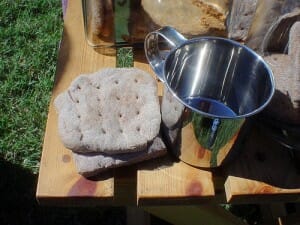 Preparations for the flight to safety after a cataclysmic event always include, at their core, emergency food contingencies. Most preppers take the measure of stockpiling foods that can survive a long shelf life and that are suitable for light-weight travel. Dried foods typically dominate the shelf space as they are the most durable and travel-friendly food alternative.
Preparations for the flight to safety after a cataclysmic event always include, at their core, emergency food contingencies. Most preppers take the measure of stockpiling foods that can survive a long shelf life and that are suitable for light-weight travel. Dried foods typically dominate the shelf space as they are the most durable and travel-friendly food alternative.
Just about anything can be dried or freeze-dried, so there can never be any complaints about variety. The real issue is which foods would provide the family on the move with the best possible chances of surviving a trek of unknown duration.
Space limitations are always a critical consideration in emergency travel and while everyone would like to have some variety of choices, the selection of foods should be based on packing the most nutritional punch into the smallest space. Contingency planning for any bug out has to include the possibility of foot travel, which more severely limits food storage capability.
To narrow down the choices to those foods that provide the greatest nutritional value while keeping within the space and weight limitations of the emergency traveler, one only has to look back in history to the survival menus of the early-American frontiersmen. Traversing vast patches of wilderness for weeks or months at a time, these venerable survivalists required a constant intake of calories and nutrition that was readily available when game and wild plant food wasn’t.
Many of the foods that were found in the packs of yesteryear’s backwoodsmen and soldiers still remain a viable, nutritious, and preferred choice of today’s survivalist. Most of them can be prepared and stored ahead of time to ensure they are in plentiful supply at the time of your bug out.
Pemmican
Pemmican has been a staple of explorers and frontiersmen for generations. Its durability and value as a nutritional energy source is well established. Simply put, pemmican is a nutrition-packed “sausage” that combines the high-protein nourishment of dried, ground jerky (deer, caribou or very lean beef) and the energy-producing power of the rendered fat of beef suet.
Preparation is somewhat involved but can be completed within a day. The rendering process takes the longest, so start by cutting the beef suet into small chunks and heating (low heat) over a stove in a heavy steel pot. It needs to be stirred frequently until it dissolves into brown liquid. Continue heating until the moisture evaporates. When it is allowed to fully cool, it will turn into a white, waxy-like tallow.
During this process, the jerky can be ground in a strong blender until it turns into a powder. You can also grind up some dried fruit to mix with the meat for added flavor. After melting the tallow into liquid form, it can be poured into the meat mixture just so it is slightly absorbed. While still warm, the new pemmican concoction can be formed into small cakes and then packaged for storage.
Pemmican is very filling and packs a lot of protein, so small portions are recommended. A small supply can provide the sustenance and nutrition needed for a good amount of time.
Hardtack (Pilot Bread)
While not the most appetizing food, hardtack was considered a favorite among Civil War soldiers, and remained a staple for the soldiers of WWI and WWII. Essentially a hard cracker, these “teeth dullers” (as they came to be known) were used on long ship voyages as a main source of energy and nutrition in an otherwise limited food galley.
In its form as a cracker or thin flat bread, hardtack can be stored and carried in good supply. When properly prepared, they have a decent shelf life. One report has it that some supplies of hardtack made for the Civil War were recycled 30 years later during the Spanish-American war.
Using a conventional oven and some elbow grease, original hardtack can be made right at home. Taking 6 parts flour and 1 part water, knead the mixture into dough. Roll the dough out onto a flour-covered tray to about ¼ inch thick and then cut into 3 inch squares. After piercing the squares several times with a knife, place them in the oven at 325 degrees and bake for an hour, turning once. The finished tacks can be set out to cool for a day until they become hard and ready for storage.
Hardtacks don’t just have to be a bland snack. They can be dipped into coffee, crushed into a porridge concoction or crumpled into soups. In any case, don’t leave home without it.
Parched Corn
Another super food that predates early American history, parched corn was considered the original trail food by the pioneers. As part of this mix of survival foods, parched corn keeps well and is essential for its fiber content that will prevent constipation.
Using dried corn kernels, parched corn is prepared in a skillet on the stove top much in the way that pop corn was prepared in the old days. Adding dried corn to a small amount of heated oil and moving it around, it begins to plump and turn brown. If it pops like pop corn, it’s overcooked. After cooling in a bowl, seasonings or brown sugar can be added.
Parched corn travels light and it is a versatile food supply. Stored in airtight containers, parched corn can be eaten as a snack or used as part of meal recipes.
These three mainstay foods of American history represent the key food groups for sustained nourishment under the most difficult conditions. The combination of protein, energy, fiber, and vitamins (vitamin C is somewhat lacking in this group) found in these light weight, compact foods are the sustenance extending solutions for your emergency food bag.
Other articles in this issue:
 Off The Grid News Better Ideas For Off The Grid Living
Off The Grid News Better Ideas For Off The Grid Living



